Appaloosa Territory
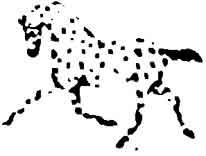
Home | Appaloosa History
Opinions-and Other Things-about Appaloosas
Paint Taint
by Rangerbred Researcher, Sherry Byrd
This is an ongoing project, and is by no means a finalization of this information. I could have went on and on with bloodlines and programs, but just got tired of doing it, and need to move on to something else
This information concerning 'paint taint' (the term I have created) is MY OPINION, based on information I have found from many different sources. I may have a stricter concept of excessive white than others have.
I would also like to thank Pat Mefferd for her research that contributed to this article.
~ Sherry
Some notes about the article below:
A name that is linked goes to an article.
A registration number that is linked goes to a photo/info on a studbook type page (Foundation, Tentative, etc).
This article published on AT with permission from the author, Sherry Byrd.
Images added by AT.~AT
To briefly scan some history:
Many of the horses of the Nez Perce had white face, leg and body markings, whether they were solid colored, pinto patterned, and/or Appaloosa patterned. Palmer Wagner, in his book The American Appaloosa Anthology, makes the statement to the effect that purebred Appaloosas did not have white markings. The records of Lewis and Clark distinctly describe horses seen in the herd belonging to the group of Nez Perce they encountered and wintered with, having leg and face markings. I would say it was a pretty sure bet that Lewis and Clark saw the Nez Perce horses, and not Palmer Wagner. Sabino, overo and other pinto/paint patterns existed in the Nez Perce herds long before the ApHC was ever an idea. Sabino, Overo and other pinto/paint patterns existed in all the Native American herds, and especially those tribes from which the Nez Perce obtained their horses. The later influx of Arabian, Thoroughbred, Quarter Horse, draft or draft cross breeds, pony breeds, Albino, Walking Horse, etc., no doubt added to the supply of "paint taint" genetics, but in NO WAY originally brought it into the breed.
Since many of the early breeders, both pre-registry and/or early registry, were ranchers, it was ranch herds from which their breeding stock came. There was almost always a variety of patterns to be found in these ranch herds-- tobiano, albino, creams, overos, and solid colored horses abounded because the horses were bred to be used and color/pattern was of little or no importance. Stallions were brought in, for specific purposes, so often one ranch had more than one breed/type of stallion. Claude Thompson not only had the Arabian Ferras, but also stood a draft stallion and a pony stallion. Who's to say that some of the pre-registry stock that Thompson had crossed with Ferras or Old Painter, might not have been products from the draft or pony stallion.
Prior to the formation of the ApHC and during the early years up to the early 1970s, many of the early breeders did in fact cross Appaloosas with Paint/Pinto patterned horses, and registered the resulting Appaloosa patterned foals. Long-time Appaloosa breeders in Oklahoma admitted to breeding Appaloosas and Paints, stating the crosses either got them a very loud colored Appaloosa or a very loud non-fading paint pattern. These breeders also claimed that the pictures used by the ApHC, that showed a mix of Appaloosa and Paint patterns rarely happened. Many of the old breeders that used tobiano mares did get a high percentage of colored foals. Among those breeders-- Chet Baldwin, the Van Pattens, Kopfers, Claude Thompson, J.E. Hiatt, Merrills, Ferguson, Holzberger, Peterson, Manes, Raser, J.J. Carey, Nate Pyle, Horace Raty, Louis Biltoft, Harold Laflin, J.F. and Rita Ryff, T.F. Osment, Fred Bixby, Mike Ruby, J.L. Rose, and many others. Ben Johnson was friends with Chet Baldwin and they often traded stock.
Baldwin also traded with the Van Pattens, the Kopfers and King Parsons. There was the Norgren, Goemmer, Spencer and Atchison programs that traded and bought between themselves to produce both Appaloosas and QHs. Even Palmer Wagner's book, American Appaloosa Anthology, brings this to light on page 526, where he notes the recollections of Dale Besst, in recounting the mixture of solids, Pintos and appaloosas being bred without management together on the South Dakota reservations after WWI.
There are photos from the J.E. Hiatt Ranch, that show Appaloosa foals with Paint/Pinto dams. One photo, showing a pinto mare with an Appaloosa foal, has a notation on the back that states the mare is sired by a leopard spotted horse, and the sire is sired by a leopard spotted horse. There are various photos of Claude Thompson's brood stock, that shows mares with high white, large white belly spots and other pinto type markings, as well as heavy wavy manes and tails. Thompson's programs also had creams. The horse Model F-16 (Young Painter X Cheyenne), bred by Claude Thompson, is said to be a black and white pinto. There is the photo of Chief Malheur foals, in the October 1951 The Western Horseman, that shows a pinto foal he sired. Chief Malheur carried a large dark mismark on his right side (ICAA Report Fall 1998.)
Then of course there are the Peavys and Coke Roberds, whose mish-mash of breeding stock became the foundation of the AQHA, the Appaloosa and even the Pinto/Paint breeds.
A) You can also include influence on the Palomino from the Roberds program, through Plaudit.
Sheik AQHA P-11, with a blaze, white muzzle and stockings, was a noted sire of the Peavy program. His descendants went into the Peavy and Weiscamp programs.
Old Fred was probably the most famous of Roberds' stallions, and is faulted for being a progenitor of excessive white. Descendants include Brush Mount AQHA, Champagne AQHA, Plaudit AQHA, Gold Mount AQHA, Sheik P-11 AQHA, Nick Shoemaker AQHA, Slipalong Wiescamp AQHA, Skipper W AQHA, Ding Bob AQHA, Smoky T AQHA.
Roberds probably got some of his breeding stock (Steel Dust mares) from the Burnett Ranch while he was in Texas, before he moved to Colorado. The Burnett stock had a lot of grays and roans, with possible Appaloosa influences from Mexico. The Burnett Ranch also brought a large group of palomino mares from Mexico, which could be the possible origin of the champagne in the QH. The Burnett lines also went into the Triangle program.
B) The Peavy program sometimes produced Appaloosas (often with a lot of white) from horses that had 3 generations of registered QHs. Peavy Bimbo and Peavy's Dandy Pants continue this trait. The Peavy bred horses nicked with Red Plaudit to produced several horses with excessive white.
Some descendants from the Peavy program that exhibit a lot of white include: Mighty Peavy's Maid, Brightest Image, Uptown Lass, Paul's Cindy, Major Plaudit Gem, Supreme Secret, Apache Gal, Alley Cat II, Treasure Cat, Spittin Cat, Plaudit Bar Robin, One Sided Affair, Tina's Blizzard, Mighty Repeat, Major Plaudit, Sargeant Gideon, BB's Silvertail, Mighty Regal, Easy Pleaser, Spanish Supreme, Annie Bright, KC's Prodeuce, Major's Plaudette, Gonna be A Rustler, Dewya Dair, Foxy Fawn.
C) Later we can add the Wiescamp program, which had a big impact on the Appaloosa breed. The Wiescamp mares-- several had misplaced white or were overo patterned, thus denied AQHA registration. Princess Rita, ApHC ID#8372, dam of Prince Plaudit, was denied AQHA registration due to having too much white.
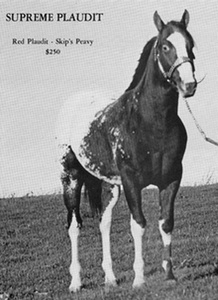
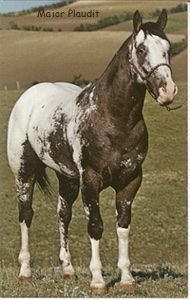
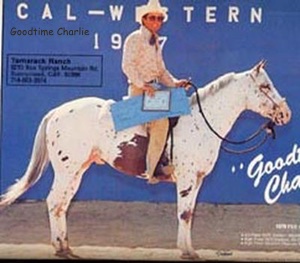
1) So, there is the family line of Red Plaudit and Prince Plaudit that carry genetics for excessive white. Red Plaudit especially nicked with Peavy bred mares to produce excessive white, including hind stockings whose points expended almost up into the flank area-- Supreme Plaudit and Major Plaudit are good examples. Prince Plaudit often nicked with Joker B (Coke Roberds lines) bred mares to produce horses with excess white. Some Prince Plaudit horses also had large areas of pigmentation (mismarks), mostly when crossed with Wiescamp lines [Good Time Charlie].
Also add the Navajo's Candy line to this family tree, through shared ancestry of Juaquin/Banjo. This would include excessive white possibilities in Ulrich bred horses through Ulrichs Many Coups. Mismarks have also been produced in the Ulrich lines [Ulrich's P.T.] The Ulrich program lines also adds Simcoe breeding, Charlie W. Peterson lines and Bambi E/Sundance lines into the mix.
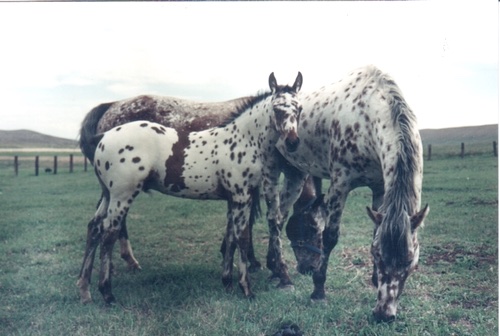
Ulrich's PT with sire Ulrich's Papillon
and dam Ulrich Timarue 260886, a "Bright" bred mare.
Her sire was
Mighty Tim (Mighty Bright x Cherry Cordial AQ)
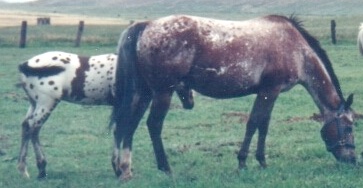
Ulrich Timarue 260886
2) There seems to be a pinto/paint tie-in with the Ferguson program as well, particularly through Bub F-1293. Bub F-1293 sired a Pinto registered (#933) chestnut tobiana mare named Bub's Little Brave; the dam being Rompers ApHC T-4649 (Tiger X Morgan mare). Bub's son Chatawa F-1524 also sired a Pinto registered foal out of a bay Saddlebred dam. Chatawa's dam was Josie Red F-1390 (Chief Joseph Rex F-688 X Flicker F-940). The Ferguson program was absorbed by Money Creek Ranch, who also had Missoula lines.
3N Rex F-1388 (Chief Joseph Rex F-688 X Ferguson's Dinah F-1140), and full sibling Little Joe F-1520, exhibited high white on 4 legs and 3 legs respectively.
The Ferguson tie-in also descends down to Chub's Powderface T-24129, used in the Scripter program. This traces to Flag F-1882 and his sire Utah F-1131. Chub's Powderface sired Little Melody HW 51518, that exhibited high white. Also behind Chub's Powderface is the Chubby AQHA line, but that line does show a tendency for only small amounts of white markings, if any, in the AQHA descendants.
Also see #9.
3) Almon and Lee Manes' Appaloosa program was based on horses that were the result of crossing Nez Perce ponies on Walking Horses, brought from Oklahoma. These Walking Horses were roany, with high white, bald faces, pinto marked and had green eyes. This is the heritage behind Silver, Blinders -- Buck F-404
4) Starbuck Leopard line, i.e. Sundance, Skeezix, Nugget Jim--
Chief Crazy Horse C F-3461, sired by Skeezix out of an unknown dam. Chief Crazy Horse sired paint/pinto patterned foals.
Skeezix is said to be sired by the Starbuck Leopard. There are several versions of pedigree for the Starbuck Leopard.
Sunray F-1277, sired by Barrendo Red F-150 (by Skeezix); out of Leopard Lady F-167, exhibits sabino markers. Ben Johnson program.
Cheyenne F-1276, sired by Lucky Boy F-406; out of Miss Sundance F-235, exhibits sabino markers. Ben Johnson program.
If one looks at the photos of Sundance F-500, you will see that there are no spots on either of his lower hind legs and same on the left front. Sundance also descends from the Starbuck Leopard, again depending on which pedigree.

Baldy's Ahu-Cka 92660 exhibited excessive white; sired by Patchy Jr, out of a daughter of Sundance F-500.
Leopard Lady F-167 also exhibited sabino indicators. She is the dam of Patchy Jr. F-1380, Patchy Jr's Baldy F-1898, Sunray F-1277 and Patchy Topa 42633 - all exhibit sabino markers.
The painting of Bambi E, appears to show a very high sock on one of the hind legs. Some of get also exhibit the same, as well as other descendants. Woodrow Shiek also exhibits sabino indicators. Other descendants that exhibit lots of white include Sully's Sorrell Lady, Sully's Sinbad, Princess Red Moon, Bigg's Blazer K.
Nugget Jim 85969 is also said to descend from the Starbuck Leopard and the Marcus Crowley program. He is known to have sired several paint/pinto foals that were sold as grade Paints. Too Brite Nugget 386255 (also mixes Bandido 34466 and Bright Eyes Brother), who has blue eyes, sired at least 1 foal with blue eyes, baldface, and 3 stockings.
Colo Gal F756, sired by Starbuck Leopard II F-129; out of Snip -NR-. [Note: ApHC Stud Book says sire is Starbuck Ranger F-129-- which is incorrect]. Mare has blue eye.

5) Little Britches K T-941, although he did not exhibit excessive white traits himself, he was well known for producing excessive white. This of course would be from his dam Lucy Palousey F-2520 (aka Lady Palousa), who was also the dam of Hands Up F-2217 (see #18). Little Britches K descendants include Roman Britches K, Kelley's Sonny Boy, Sundance Geronimo 309803, Sug Bars, Popsicle Jay, Cedar Ridge Spot, Prince Hancock 110512, Shalako's Plaudit 175427, Angel Flair Spot, RKP's Buzz Off, to name only a few.
6) The Dewey Norell program-- produced several horses with excessive white. The Norell program, like the Peavy program, produced Appaloosas with QH parentage. Some of these horses went into the Carey program, who also got breeding stock from DeVidts and Pyle (Colorado).
Carey's Attaadi T-858 (Bularo -NR- X Star duster -NR-), sporting a bald face and 3 stockings, was the dam of Joker Jack 9787 (by Joker B).
Carey's Streak T-857 (Cooterville Norell's Little Red F-1673 X no dam given in Stud Book), had a bald face and 2 stockings.
Carey's Shaanappi T359 (Appaloosa X unknown), stockings.
Carey's Hired Hand T6852 (Trammell's Squaw Man 1949 X Red Bug -NR-), baldface. Trammell's Squaw Man is double-bred Rainy Moon F181 (see #16)
Carey's Bimbino T9593 (Peavy Bimbo T-1167 X Gold Heels mare), high white
Carey's Top Hand T6851 (Trammel's Squaw Man 1949 X Carey's Measles T6850), baldface. Trammell's Squaw Man is double-bred Rainy Moon F181 (see #16)
Carey's Frosty K T-3347 (Frosty Britches -NR- X Mabel -NR-), stockings
7) The Mansfield Comanche line , particularly the Double Six Domino line, is also known for horses with a lot of white. I just finished a research project concerning Buttons B., son of Double Six Domino, that had over 80 pages of descendants. The number of Mansfield Comanche descendants is huge and wide-spread throughout the breed, and has been bred into many other family lines. Hawkeye, from the Double Six Domino line, also has produced excess white, including Perry Pro, Gold Strike's Equal and Silver Strike's Equal (both by Comanche's Equal), exhibit sabino traits. Boomer Britches (by Navajo Britches) exhibits sabino traits. Dominette and Earl's Double Six Domino (by Double Six Domino) exhibit sabino traits. Durango (also Toby bred) and Kiamichi Brave exhibit sabino markers. Some Abdull's Pok-A-Son descendants also exhibit sabino markers. The Mansfield Comanche line also seems to have a trait for large misplaced white spots, usually on the neck and/or shoulders, but do appear elsewhere on the body.
8) Howard Raser program-- Missoula, was once one of the largest groups of Appaloosas in the U.S.; later sold to Charlie W. Peterson, who then had the largest herd. Many of these horses were of unknown breeding, being purchased at sales throughout the country. Horses from the Raser and Peterson programs went into Money Creek Ranch's program.
Missoula Squaw 68093, sired by Missoula Medicine Man F-2824, out of Squaw of Medicine. Photo shows her to have high whites and a baldface. Her sire does not show such obvious indicators, but source could be from either sire and/or dam.
There is a photo of three Raser foals, one of which has an obvious mismark on the right side. Missoula Arrow T-3606 also has a mismark.
9) Lucky DazeT28233, excessive white on face and legs. Sired by Syringa Possum F-2742 (Chocolate Soda T-56/F-2735/ X Steptoe F-1387); out of an unregistered mare called Arabian Princess. Chocolate Soda T-56/F-2735 is sired by Golden Glow F-470 (Crowley program); out of a mare named Paint. Steptoe F-1187 is sired by Chief Joseph Rex F-688; out of Nifty F-1136 (Butch X Ferguson's Snowflake F-1130).
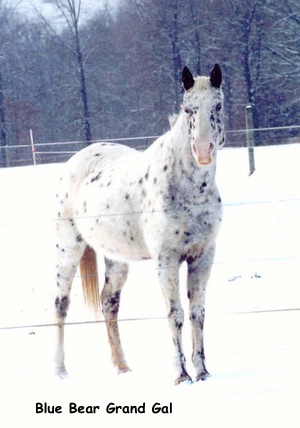
10) Apache F-730 had sabino indicators. This line went into programs like Cloval, Kyloe, Missoula, Scripter, Ben Johnson, Eagle Nest Ranch, Heritage, Idahills, Palmer Wagner, OK program in Canada, Ferguson, Minidoka, Pratt, Kline, Circle L Farms, among others. Descendant Blue Bear Grand Gal 348879 has a wide blaze that covers the muzzle to from nostrils to the forehead, and almost to both eyes. Other descendants with sabino indicators include Apache Double, Double Patch, Chicaro's Chicadee, A-Pache Miss 730, A Apache Scooter. Also has descendant with mismark.
11) Simcoe's Scappose F-1887-- sire is Polar Star The Second F-1554 (Chief Eagle F-288 X Twinkle Star F-723); dam is Flash's Pepper F-63 (Flash F-12 X Marvel's Angel F-4).
12) Quinta Chief T-236 (Catechu AQHA P1331 X Sally Rand F-1527 [Smoky T AQHA P1147 X Blue Vitriol {dam of Joker B}]) exhibited sabino indicators-- sons Qunita's Pride T-23781 [Appaloosa News 1-65:92] and Quinta's Racer 23783 exhibit sabino indicators too. Quinta Chief's full siblings Tulare T-234 and Peter Freckles T T-235 [Appaloosa News 9-68:8] also are described as exhibiting sabino markers.
13) Spotted Eagle F-208 sired by El Zorro F-108 (Flash F-12 X Marvel's Angel F-4), out of Daybreak F-155. Sire is full sibling to dam of Simcoe's Scappoose (see #12). Has sired horses with lots of white, including Marquita F-1262, whose dam is Margo F-15 (Ferras AHC X Marvel's Angel F-4). This stallion was used on numerous unregistered ranch mares (Diamond Two, McDannald, Hartsel, 101), which again probably included pintos/paints or descendants of such breeding.
One of most noted producers was daughter Puss ID9027, dam of Prince Rocky 159828 [Appaloosa News 9-75:97], Money Creek's Princess Puss ID 5539, Prince Frank 141551 [Appaloosa News 8-71:bc], Bright Son 17722 [Appaloosa News 7-66:65], Bright Cash 27254[Appaloosa News 8-67:12], Bright Robin 8516.
Progeny with sabino markers, including Wa-Pi T-3974, Miro's Spotted Eagle T-4544, Flight Eagle 18790, Skeeter Babe.
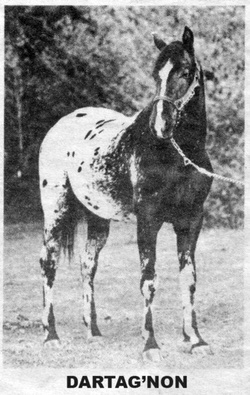
14) Freel's Chico F-715-- pictures show high white. You can find this descending line in Dartagnon 294406, Tobys Lucky Moon 495594, Snowcap's Traveler, Simcoe's Pataha (pedigree in question as to descending from Freel's Chico), Chico's Snowcap F-3254, Sly Stallone, KGL Cracklin Rose, Bar Sassafrass, Bar JJ 79S, Spring's May, Double Arrow, Skip's Fancy Girl, Jack's Hombre, Chico's Sundowner, and several others. This line can be found in the Idahills program, the Simcoe program, and the Fruhling program among others.
15) Red Eagle F209-- although he did not exhibit excessive white himself, several of his descendants did exhibit high white and wide blazes. Red Eagle is sired by Ferras AHC 922 (known to carry sabino through Mesaoud); out of Painter's Marvel F-47.
In further reference to Claude Thompson's program, the unregistered mare named June's Mare is shown to have a large area of misplaced white on her belly. This descending line can be found in Babe F-1, Snowstorm F-7, Sharon F-11, Leopard F-24, Dot F-25, among others.
Also in reading through some of these other lines that are known to produce paint taint, the Thompson product Marvel's Angel F-4 is found more than once. This descending line can be found in Painter III F-8, Chief F-13, Margo F-15, Bambi F-446, Palousie F-26, Painter's Marvel F-47, Flash's Pepper F-63 (see #12), Appalo F-81, Princess Beryl F-85, El Zorro F-108, El Blanco Indigo F-111, Pawnetta F-122, Waneta F-156, Indian Princess F-207, Spotted Eagle F-208 (see #14), Red Eagle F-209, Peacock's Miraklman F-2190 , Thunders Mr Magpie 217627, Sage King R F-2668, among many others.
Red Eagle descendants that exhibit excessive white include Rusty B (by Red Eagle's Mark of the 1001), Flying M Chinook Pepper (by Simcoe's Chinook), Patches Waco (by Chinook's Waco), 7-C's Red Eagle's Pride, Chinook's El Prince (by Simcoe's Chinook).
Unfortunately the first 500 foundation numbered horses listed in the ApHC Stud Books, are not listed with any face or leg markings. I do not believe that all of the first 500 horses registered had no white markings.
Claude Thompson was a well known Arabian breeder (more so than being known for Appaloosas). Many of the Arabian descendants of Ferras from his program show sabino markers. Ferras grandson Royal Flush AHC 19337 sired/grandsired ApHC registered horses. Ferras grandson Rabiycar AHC 8586, who was the grandsire of ApHC registered horses, not only exhibited sabino markers, but passed them on to his foals.
16) Rainy Moon F-181 (aka Patches prior to registration)-- product of the Van Patten and Baldwin programs, and used in the King Parsons program, Said to be (ApHC pedigree) sired by Iron Tail -NR- (Iron Jaw X Sisuki Kiye); out of Popo Agie -NR- (Government Draw X Ashurava).
Actual pedigree-- sire was half Morgan, paternal grandsire a registered Morgan from Idaho. Dam was an Appaloosa mare about 3 generations from an Indian mare and registered Hambletonian (Standardbred) named Erlander. Note: further research shows that the registered Morgan in the aforementioned statement was one generation off. The correct version of the pedigree was presented to the ApHC years ago, but the correction has never been made in the records.
This line was used in the Carey program, the Kopfer program, the Tolan program, Harold Wingate program (if one believes that Rainy Moon sired Granite Canyon), Way Lo Acres, Melvin Sweat program, Danley program, DREA, and others.


Nifty Man
17) Miller Mare-- not all of the mares denoted as Miller mare in pedigrees carried paint taint. But some did. There is record of foals sired by Ranger Hancock AQHA3994, when crossed on Miller mare (s), but the excess white did not come from Ranger Hancock.
Information obtained from old research states that Chicaro Bob F-2676 comes from Paint heritage.The information says that Chicaro Bob's dam was sired by an overo paint that the ApHC called spotted horse. Looking at the ApHC Stud Book, Chicaro Bob is sired by Chicaro F-2028; out of the mare Bobbie N F-2675. The ApHC gives Bobbie N's pedigree as being sired by Ranger Hancock AQHA 3994; out of Miller Mare. Jan Haddle's book, The Complete Book of the Appaloosa, shows Bobbie N's dam to be Miller mare by Ding Bob II. Ding Bob II (Saladin X Flossie) was an Appaloosa patterned "Quarter Horse", with lots of white markings, a product of the Coke Roberds program. Bobbie N also showed lots of white on her legs, and produced the same with son Nifty Man 116466, and other foals. The ApHC pedigree does not match the paint information from the past, but it is possible that the paint influence may be behind the Miller Mare in the pedigree. Of course Chicaro Bob also has sabino influence from his sire Chicaro, son of Apache F-730. Chicaro Bob descendants Oklahoma Grasshopper 51173 and Brite Eye Robin 51174, both with high white and baldfaces.
Joker's Monte 28264 (Joker B line) descends from a Miller Mare, as does Three Suns 101754 (SD500 line), through his granddam Miller 67 mare.
18) Hands Up F-2217-- one of the most blamed horses for excessive white in the breed. Half-sibling (maternal) to Little Britches K T-941, one of the overlooked excessive white lines. Excessive white had to have come from the dam, Lucy Palousey F-2520, whose pedigree is uncertain.
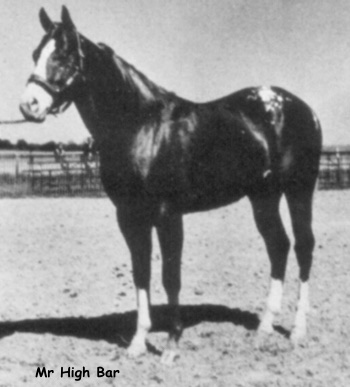
Son High Hand exhibits high white and bald face. High Hand Man (by High Hand) exhibits high white and bald face. Hi Lo 17924 (by High Up by High Hands) exhibits baldface. Cuchara High Hand (by High Hand) exhibits high white and bald face. Diamond Hands T52608 exhibits high white and large blaze covering muzzle. Indian Hand (by Hands Up) exhibits bald face. Docs First Lady T252709 (by High Hand Junior) baldface and 4 stockings. Bugs J Man exhibits high white, baldface and belly spots. Mr High Bar (by High Hand) exhibits sabino traits. Jack High (double-bred High Hand) exhibits high white and an apron face. The Bandidio line also descends from Hands Up, through sire Golden King. The Bandido line still gets blue eyes and excessive white on occasion.
Other descendants that exhibit excessive white include Sunday Punch, Valley Hi, Golden hand, High Honor, Midday Sarah, Hands Up Brigitte, Rocky Hand, Extra Effort, Little Linda, All Lacie, Cheta's Doll, Super Hi-Bar, One Sided Affair, Hands Favor, Here's Johnny, High Award, Heza Bar Hand, Poker Hand. The Hands Up line is still currently active through All Hands On Zip.
19) Pancho Boy F-777, sired by Pancho -NR-; out of unknown mare. Known Paint horse, bred in Colorado, and owned in Idaho.
20) Painter's Shiek F-884, sired by Young Painter; out of black/white pinto mare named Jocie. Has ApHC registered progeny.
21) Little Man S F-1789/CRHA 690, sporting a baldface and high white, is said to descend from both Rainy Moon and Starbuck Leopard. ApHC pedigree shows the connection to Rainy Moon, but not to Starbuck Leopard. Little Man S's sire is Coeur d'Alene F-145 (Rainy Moon F-181 X Little Perposia -NR-); and his dam is Corky F-1201 (Red Fox -NR- X Minnie Mouse -NR-), who also had high white.
22) Chief Navajo F-1970-- descending line from early Babcock program (Babcock lines later went into Marcus Crowley program). This line is in the Absarokee Sunset family, as well as the Ulrich program.
Joe's Little Navajo T83524, by Little Navajo Joe T30022 (dam is Navajo Turquoise of AA by Chief Navajo); dam is Miss Buzzy of 9 Over Lazy 9 (by Flamingo of AA by Chief Navajo), exhibits sabino markers.
Absarokee Sunset, Absarokee Sun, and Absarokee Sug Bars all exhibited sabino markers. Powdered Sugar, dam of Absarokee Sunset and Absarokee Beaver is said to carry draft genes, which could possibly be a source for excessive white, depending on breed of draft ancestry. Other descendants known to exhibit lots of white include: Avenger's Justice, Snorten Coke Duncan Hines, Absarokee Trojan, Joker's Flamingo Joe, Double H Wrangler, Sun Top, Juliet, The Hustling Man, Mismarks can also be found [Absarokee Sunrise].
23) Looka F-170 (unknown parentage) was a stallion used in the Ryff program. He sired stockings and wide blazes on some of his foals, including El Dia F-914 and Ryff's Bonita F-913.
24) Bright Eyes Brother F-3048 is erroneously considered to be the biggest culprit of excessive white in the Appaloosa breed. It has been proven that not all of his descending lines continue to produce excessive white. The occurrence of excessive white seems to be often a result of multiple BEB lines in the pedigree, but not always. His culprit genes come from his dam Plaudette, a product of the Coke Roberds program and Old Fred.
Bright Reflection, Exclusive Blueyes (Peavy breeding), Exclusive Dundee, Bright Son T17722, Mighty Peavy, Mighty Replay, Mighty Bright, Bright Delight, Spittin Image (Peavy breeding), Mighty K Britches (Little Britches K breeding), Mighty Slick Doll (Prince Plaudit breeding), Bright Robin, Bright Light, Semi-Tuff, Mighty Sheik are some of the descendants that continue the excessive white traits
Mighty Bright 9760 sired Fredette PtHA 7219 (brown overo), out of Cutch's Silver AQHA 64304 (Coke Roberds breeding). Full siblings to Fredette include Mighty Ute, Road Agent and Mighty Silver Ute, all registered Appaloosas.
25) Linden Pinto F-191 (m) -- sired by Linden Tree; out of Pinto; had blue eyes.
26) Toby lines-- although the main Tobys, I, II, III, and IV did not show sabino markers, many of their descendants do in fact exhibit sabino traits, including high leg white and very wide blazes (some bordering on baldfaces). Ken Bliven's Kuetan program produced a quite a few horses with sabino traits. This line went into the Pratt and Palmer Wagner programs, among many others.
Some of the descendants exhibiting lots of white include Living Dolly, Smohalla Toby, Artesian Catamount, Kuetan's Two Bears, Kuetan's Wa-Ka-Si, Kuetan's Wish Poosh, Tyee's Snowcap Joe, Kuetan's Princess, Blue Bear Grand Gal, Polkadott Toby, Snowcap of Green Stables, Kaniksu's Sheet Lightning, R.O.'s Kathy and Sequined Prince.
Sequined Prince probably has the highest percentage of descendants with lots of white. He carries 3 crosses to Toby. He also traces back to Chief Malheur (known to have sired paint/pinto), and has a line from the Manes program through Riley's May. Also possible descendant of the sabino trait Arabian Aldebar AHR 1864 (aka Aldebaran AHSB 103), who traces to Mesaoud.
Jedriss AHC 3664, sire of Riley's Purple Doll F-3156, exhibited high white and a large blaze. This line can be traced in Artesian's Toby's Chief (along with Chief Malheur), Joseph Plains, Sequined Prince and Keutans Toby.

Chief Malheur
27) Chief Malheur-- There is the photo of Chief Malheur foals, in the October 1951 The Western Horseman, that shows a pinto foal he sired. Chief Malheur carried a large dark mismark on his right side (ICAA Report Fall 1998.)
Don O's Baldy traces back to Chief Malheur.
Other horses/bloodlines, not further detailed, include: Illusion, Lotta Sand Belle, Tumalo Marvel, RO Princess Pat, Kenny's Chief, Clayhill's Silver, El Deabloo, Mindoka Apache Princess, Chief Rainmaker, Indian Bend Snooper, Mister Blue, Rodeo Day, Paisano, Blitz, Peter K, Chief Montana J, Robin, Peter Ehrlich, Olympic Valentine, Rustler Bill (according to Palmer Wagner), Zipper W, Mr. Bounce, Slim Pickens, Sid Rico, Hernando of Hideaway, Bald Eagle's Sir Dixon of Illingdale Farms, Pima Metoaka, Idahills Chickadee, Christina, Pfeffer's Bunny, Kingfisher, Ringo Q, Pop Up's Dancer, Peso's Pache Joe, Simcoe's Lucy J, Chief Take Um Cash, Paloosa Joe, Chief Bob-Alooie, Pepper's Red Eagle, Scott's Little Fawn (Missoula line), Columbine Singing Song, Arboledo's-Timker-Tom-L, Mitchell Mare #34, Ozark's Georgia May, Rocky Branch, Ozark's Hired Man, Ekins Promenade, Sheri Patchy (by Patchy), Patches Waco, Adams Prince Fourmile, Norgren's Baldy Fly, Minidoka LBJ, Tumalo Clipper's Nanette, Tee Camet's Tony, Harvey's Bingo Happy, Osage Orange, Dobbin Q, Casper Cloud, Whoop's Triangle, Rocket Bye Baby, Cherry Sundae K.S., Underhile Borkaan, Taykota Tetonka, Ahlstrom's Betty J, Ruff's Weather Beat, Kiss The Sky Dargo, Go Cart Impresser, Bright Revel Morrocco, Continental Rock, Coke's Checkmate, A Spanish Doll, Ashley Too, Jetset Playgirl, Prince Magnum, Quinta's Pretty Girl, Dr. Raffles, X+ Do Bob, Chico's Domino , Goodbye Charlie (Trammel's Squaw Man lines), Calico Kisses, Head's Up Skip, Shehaqua, Sir Echo, Don O's Baldy (Chief Malheur line), Sil Patch (Patchy), The Hustlin Man (Absarokee Sunset),Poncho's Little Elk, Wapsies Sarkie Dudes G, Joker's Corker, Little Linda, Miss Top Plaudit, Co-Tone, Charles Charm, Personal Preference, Princess Merrilee, Hecoma Billy Babe, Mr. Gad About, MightyBonus, Sky hawker (Bandido), Gid-Em Up Scout (Biltoft), Mighty Texas, Duncan Hines, Mighty Kentuckian, Easy Pleaser, Monte's Best Bar, Pro-Cocious, Prince Charmin V.H., Wiley Post, Mighty Ding Dong, C B Riker, Quick Request, Brandy Boots, Snow Ball Britches, Kelly K McCardo, Little Quavo, Arrows Shamrock B, Vitrol Dashaway, Paleface Dynamite, Zip Reed (Rustler Bill), Circle S Brite Penny, Circle S Domino's Fancy, Head's Wenonah, Impasse, Countri Sunshine, BBF's SS Janari, BBF Ariel Sun, Comanche Debra, Hot Heels, Lancer's Thumbprint.
(Appaloosa) Opinions
Home | Appaloosa History
This page posted March 2018; last updated March 11, 2018.